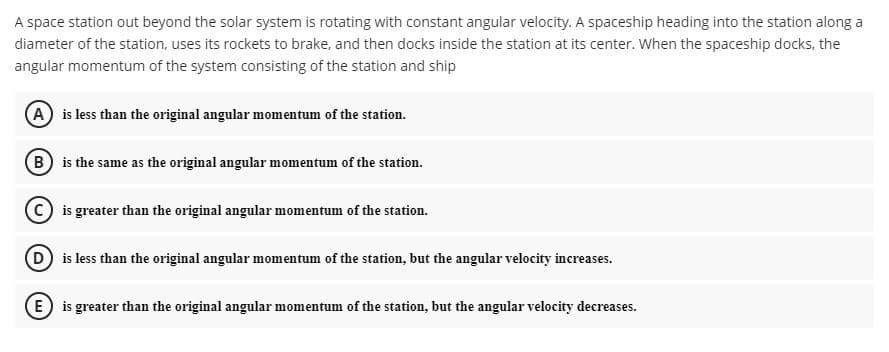A space station out beyond the solar system is rotating with constant angular velocity. A spaceship heading into the station along a diameter of the station, uses its rockets to brake, and then docks inside the station at its center. When the spaceship docks, the angular momentum of the system consisting of the station and ship (A) is less than the original angular momentum of the station. (B) is the same as the original angular momentum of the station. C is greater than the original angular momentum of the station. D is less than the original angular momentum of the station, but the angular velocity increases. E is greater than the original angular momentum of the station, but the angular velocity decreases.
A space station out beyond the solar system is rotating with constant angular velocity. A spaceship heading into the station along a diameter of the station, uses its rockets to brake, and then docks inside the station at its center. When the spaceship docks, the angular momentum of the system consisting of the station and ship (A) is less than the original angular momentum of the station. (B) is the same as the original angular momentum of the station. C is greater than the original angular momentum of the station. D is less than the original angular momentum of the station, but the angular velocity increases. E is greater than the original angular momentum of the station, but the angular velocity decreases.
Glencoe Physics: Principles and Problems, Student Edition
1st Edition
ISBN:9780078807213
Author:Paul W. Zitzewitz
Publisher:Paul W. Zitzewitz
Chapter9: Momentum And Its Conservation
Section: Chapter Questions
Problem 1STP
Related questions
Question
q3

Transcribed Image Text:A space station out beyond the solar system is rotating with constant angular velocity. A spaceship heading into the station along a
diameter of the station, uses its rockets to brake, and then docks inside the station at its center. When the spaceship docks, the
angular momentum of the system consisting of the station and ship
(A) is less than the original angular momentum of the station.
(B) is the same as the original angular momentum of the station.
C is greater than the original angular momentum of the station.
D is less than the original angular momentum of the station, but the angular velocity increases.
E is greater than the original angular momentum of the station, but the angular velocity decreases.
Expert Solution
This question has been solved!
Explore an expertly crafted, step-by-step solution for a thorough understanding of key concepts.
This is a popular solution!
Trending now
This is a popular solution!
Step by step
Solved in 2 steps

Recommended textbooks for you

Glencoe Physics: Principles and Problems, Student…
Physics
ISBN:
9780078807213
Author:
Paul W. Zitzewitz
Publisher:
Glencoe/McGraw-Hill

Physics for Scientists and Engineers: Foundations…
Physics
ISBN:
9781133939146
Author:
Katz, Debora M.
Publisher:
Cengage Learning

Principles of Physics: A Calculus-Based Text
Physics
ISBN:
9781133104261
Author:
Raymond A. Serway, John W. Jewett
Publisher:
Cengage Learning

Glencoe Physics: Principles and Problems, Student…
Physics
ISBN:
9780078807213
Author:
Paul W. Zitzewitz
Publisher:
Glencoe/McGraw-Hill

Physics for Scientists and Engineers: Foundations…
Physics
ISBN:
9781133939146
Author:
Katz, Debora M.
Publisher:
Cengage Learning

Principles of Physics: A Calculus-Based Text
Physics
ISBN:
9781133104261
Author:
Raymond A. Serway, John W. Jewett
Publisher:
Cengage Learning

College Physics
Physics
ISBN:
9781285737027
Author:
Raymond A. Serway, Chris Vuille
Publisher:
Cengage Learning

Physics for Scientists and Engineers, Technology …
Physics
ISBN:
9781305116399
Author:
Raymond A. Serway, John W. Jewett
Publisher:
Cengage Learning

Physics for Scientists and Engineers with Modern …
Physics
ISBN:
9781337553292
Author:
Raymond A. Serway, John W. Jewett
Publisher:
Cengage Learning